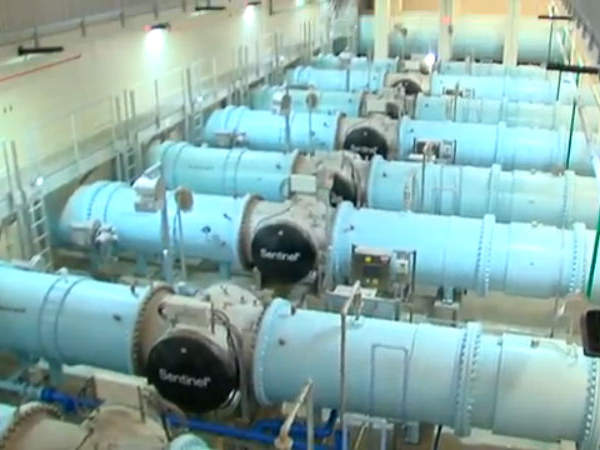State-of-the-art UV System Will Offer Protection from Cryptosporidium
The Greater Cincinnati Water Works has installed ultraviolet technology in its water treatment facility.
After 10 years and $30 million dollars, the new UV technology process puts Cincinnati on par with some of the top water systems in the country. The UV lights, which are housed inside massive pipes, will disinfect 40 million gallons of water a day.

Eight Calgon Carbon Sentinel® 48” Chevron UV reactors will have the capacity to treat up to 240 million gallons of drinking water per day.
The 20-kilowatt lamps will kill virtually any germs that make it through the conventional filtration process, which is important considering some of the challenges of the Ohio River, Cincinnati’s water source.
One of the city’s main concerns and a prime reason for installing the system is cryptosporidium. Here is a statement excerpted from the city’s website:
Treating Water With Ultraviolet Light
Construction under way at Greater Cincinnati Water Works’ (GCWW) Richard Miller Treatment Plant to install Ultraviolet (UV) Disinfection treatment technology — one of the most significant advancements in water treatment technology since Granular Activated Carbon (GAC) became the standard in the 90s.
UV disinfection has been identified by the US Environmental Protection Agency as one of the best technologies to inactivate pathogenic microorganisms, such as Cryptosporidium (crypto) in drinking water.
GCWW will be the largest water utility in North America to use UV following sand filtration and Granular Activated Carbon absorption, creating a true multi-barrier treatment approach to protecting public health.
To reduce GCWW’s carbon footprint, a component of the UV project includes installation of solar panels atop the new facility and a second installation on existing Water Works facilities.
The entire project (UV and solar) is designed to protect public health with advanced water treatment technology and protect the environment by advancing the use of solar energy.
As currently designed, this solar project will represent one of the largest solar-generated electric supply installations in Ohio.
Why Do We Need UV Disinfection Treatment?
UV disinfection uses UV light, in low doses, to inactivate disease-causing protozoa such as Cryptosporidium and Giardia. No chemicals are added, and there is no residual effect once the water leaves the UV reactor.
There are many serious concerns about the vulnerability of the Ohio River watershed to contamination, including microbial and viral contamination from emerging microorganisms that are resistant to chlorine disinfection, as well as future contamination issues that will need to be addressed. Since 2000, GCWW has been conducting research with national and international groups on technologies available to address these concerns.
In 1993, a deadly waterborne disease outbreak from Cryptosporidium occurred in Milwaukee, Wis. Nearly 400,000 people became ill, and more than 100 deaths were reported. Chlorine, which is a commonly used disinfectant at water treatment plants, is ineffective in killing Cryptosporidium. UV disinfection at water treatment plants is a proven and effective technology for addressing this contaminant.
Wastewater treatment plants release discharges of municipal wastewater into the Ohio River. Although discharges are regulated, several contaminants of concern, including crypto, are found in wastewater effluents. Municipal and residential wastewater systems and wastewater treatment plants are known to have incidents of raw sewage discharge or treatment malfunctions.
GCWW and the City of Cincinnati have consistently expressed concerns regarding a wastewater treatment plant located near Alexandria, Ky., discharging just 11 miles upstream of our drinking water intakes.
New or unexpected contaminants are sure to be discovered in our source water in the future. UV disinfection, combined with GCWW’s current treatment processes, provides an extra layer of protection against those contaminants. This is an important step in insuring public health now and for future generations.
These issues remind us how precious our source waters are and how important it is to protect them from harmful substances. The best way to insure safe water at the tap is to keep our source waters clean.




